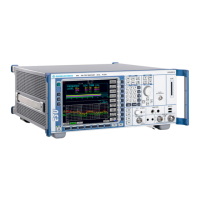R&S ESU Instrument Functions
Basic Settings
4.284 Operating Manual 1302.6163.12 - 03
Parity – Bit parity check
Remote command: SYST:COMM:SER:PAR NONE
Stop bits – Number of stop bits
Available are 1 and 2. The default setting is 1 stop bit.
Remote command: SYST:COMM:SER:SBIT 1
HW-Handshake – Hardware handshake protocol
The integrity of data transmission can be improved by the use of a hardware hand-
shake mechanism, which effectively prevents uncontrolled transmission of data and
the resulting loss of data bytes. For hardware handshake additional interface lines
are used to transmit acknowledge signals with which the data transmission can be
controlled and, if necessary, stopped until the receiver is ready to receive data
again.
A prerequisite for using hardware handshaking is, however, that the interface lines
(DTR and RTS) are connected on both transmitter and receiver. For a simple 3-wire
connection, this is not the case and hardware handshake cannot be used here.
Default setting is NONE.
Remote command: SYST:COMM:SER:CONT:DTR OFF
SYST:COMM:SER:CONT:RTS OFF
SW-Handshake – Software handshake protocol
Besides the hardware handshake mechanism using interface lines, it is also possi-
ble to achieve the same effect by using a software handshake protocol. Here, con-
trol bytes are transmitted in addition to the normal data bytes. These control bytes
can be used, as necessary, to stop data transmission until the receiver is ready to
receive data again.
In contrast to hardware handshaking, software handshaking can be realized even
for a simple 3-wire connection.
One limitation is, however, that software handshaking cannot be used for the trans-
mission of binary data, since the control characters XON and XOFF require bit com-
binations that are also used for binary data transmission.
NONE no parity check (default setting)
EVEN even parity check
ODD odd parity check

